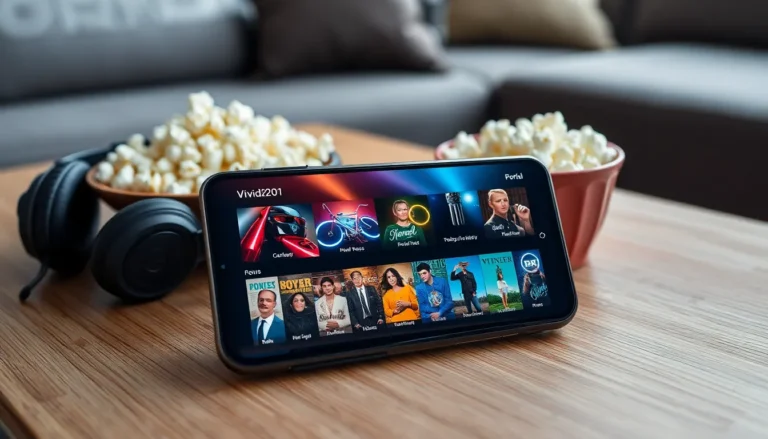In a world where your coffee maker can send you a text and your fridge knows when you’re out of milk, it’s no surprise that medical devices are getting in on the action too. Welcome to the Internet of Medical Things, where pacemakers and insulin pumps are just a Wi-Fi connection away from making life easier. But hold on to your stethoscopes—this tech marvel comes with a side of security risks that could make even the bravest IT professional break into a sweat.
Table of Contents
ToggleOverview of Internet of Medical Things Security
The Internet of Medical Things (IoMT) comprises interconnected medical devices that generate vast amounts of data. Security becomes a critical issue as these devices collect and transmit sensitive patient information. Attackers target vulnerabilities in these devices, leading to potential breaches of personal health data.
An alarming statistic shows that nearly 80% of medical devices in hospitals lack proper security measures. This statistic underscores the urgency for robust security protocols. Cyber attacks on medical devices can disrupt essential services, risking patient safety and privacy.
Common threats include unauthorized access, data breaches, and ransomware attacks. Each of these threats poses significant risks to healthcare providers. Implementing strong authentication methods and encryption can help mitigate these risks.
Many healthcare organizations are adopting security frameworks tailored for IoMT. Guidelines from the National Institute of Standards and Technology (NIST) provide comprehensive strategies for managing risks associated with connected medical devices. Integrating these frameworks can significantly enhance device security.
Regulatory agencies such as the Food and Drug Administration (FDA) emphasize the need for cybersecurity practices in device development. Manufacturers must prioritize security during the design and production stages. Continuous monitoring and regular updates are essential to protect against evolving threats.
Patient education also plays a vital role in IoMT security. Healthcare providers must communicate the importance of safeguarding personal health information. By fostering a culture of security awareness, organizations strengthen their defenses against potential vulnerabilities.
Key Challenges in Internet of Medical Things Security

Significant challenges impact the security of the Internet of Medical Things (IoMT). Addressing these challenges is essential for safeguarding patient data and maintaining trust in connected health technologies.
Data Privacy Concerns
Patient data privacy remains a critical issue in IoMT. With interconnected medical devices, sensitive data is vulnerable to unauthorized access. Reports indicate that nearly 80% of medical devices lack proper security measures, heightening privacy risks. Data breaches can lead to compromised personal health information, resulting in financial loss and identity theft. Organizations must ensure compliance with regulations like HIPAA, which emphasize stringent data protection standards. Continuous training of healthcare staff on data handling practices enhances awareness of privacy concerns.
Device Vulnerabilities
Device vulnerabilities present another significant challenge. Many medical devices run outdated software, which makes them susceptible to exploitation by cyber attackers. Inadequate security protocols allow unauthorized entities to gain access to critical systems. The FDA advocates for incorporating cybersecurity measures during device design and production. Regular software updates and rigorous testing can help mitigate these vulnerabilities. Implementing robust authentication methods further secures devices against tampering and unauthorized use. Enhanced monitoring of medical devices can detect unusual activity, providing an additional layer of protection.
Best Practices for Internet of Medical Things Security
Implementing effective security measures is critical for protecting the Internet of Medical Things. Organizations must adopt best practices to ensure the safety of sensitive patient data and interconnected devices.
Implementing Strong Access Controls
Establishing strong access controls prevents unauthorized users from accessing medical devices. Multi-factor authentication adds an extra layer of security, requiring users to provide additional verification methods. Unique user accounts should be created for all personnel, limiting access based on role and necessity. Implementing role-based access controls helps manage user permissions appropriately, ensuring that only authorized personnel interact with sensitive data or devices. Regular audits of access logs can identify any unauthorized attempts, providing insight into potential vulnerabilities.
Regular Software Updates and Patching
Regular software updates and timely patching minimize vulnerabilities in medical devices. Manufacturers must develop a schedule for updates, ensuring devices receive the latest security enhancements. Medical facilities should also prioritize applying critical patches as soon as they become available. Outdated software can expose devices to threats, making maintenance essential for security. Establishing a systematic approach to identify and address vulnerabilities helps protect patient data from evolving cyber threats.
Regulatory Compliance in Internet of Medical Things Security
Regulatory compliance is crucial in the realm of Internet of Medical Things (IoMT) security. It ensures that medical devices adhere to established security standards. Compliance with regulations like the Health Insurance Portability and Accountability Act (HIPAA) protects sensitive patient data, reducing the risks associated with data breaches.
Healthcare organizations must align their security practices with guidelines set by agencies such as the Food and Drug Administration (FDA). The FDA emphasizes a proactive approach to cybersecurity in device design and production. They advocate for continuous monitoring and regular updates to address emerging threats effectively.
Many healthcare providers leverage frameworks created by the National Institute of Standards and Technology (NIST). These frameworks provide comprehensive strategies for managing the security risks linked with connected medical devices. The integration of robust access controls coupled with multi-factor authentication enhances overall security.
Regular software updates are essential for maintaining device integrity. Unpatched software often leads to vulnerabilities exploited by cyber attackers. Cybersecurity assessments should become routine, ensuring that devices remain secure throughout their lifecycle.
Additionally, fostering a culture of security awareness within healthcare facilities is imperative. Educating patients and staff about potential threats contributes to better compliance with security protocols. In turn, this proactive approach minimizes the chances of unauthorized access and data breaches.
Monitoring for unusual activity plays a significant role in maintaining compliance. Healthcare organizations that implement enhanced monitoring can quickly detect and respond to security incidents. Overall, prioritizing regulatory compliance forms the backbone of effective IoMT security.
Future Trends in Internet of Medical Things Security
Emerging trends highlight the importance of advanced security measures within the Internet of Medical Things (IoMT). Enhanced encryption technologies are expected to play a crucial role in safeguarding sensitive patient data. These technologies add layers of protection against unauthorized access and cyber threats.
Healthcare organizations are increasingly prioritizing risk assessment frameworks. Compliance with evolving regulations and adherence to guidelines set by agencies, like the FDA, gain prominence. Continuous monitoring and regular software updates help mitigate vulnerabilities and combat potential data breaches.
Artificial intelligence and machine learning applications are gaining traction in identifying security threats. These technologies analyze patterns in network traffic, providing healthcare providers with timely alerts on unusual activity. This proactive approach minimizes the likelihood of ransomware attacks and data breaches.
Establishing collaborative security strategies among device manufacturers and healthcare providers is essential. Engaging all stakeholders fosters a culture of shared responsibility for security. Regular training programs ensure that employees remain informed about the latest security practices.
In the future, connected medical devices will likely emphasize user authentication. Multi-factor authentication methods will become standard, further reducing the risk of unauthorized access. Role-based access controls help manage permissions effectively, securing devices against potential threats.
Regular audits of security measures will likely be commonplace. These audits verify compliance with federal regulations and enhance overall security posture. By prioritizing cybersecurity practices, healthcare organizations safeguard sensitive patient information and reduce risks.
Navigating the evolving landscape of IoMT security necessitates agile responses to emerging threats. Increased collaboration and innovation in security solutions promise to strengthen defenses against potential cybercriminals. The integration of advanced technologies and steadfast commitment to security practices will shape the future of IoMT security.
The security of the Internet of Medical Things is crucial as healthcare continues to evolve. With the rise of interconnected devices comes the responsibility to safeguard sensitive patient data. Organizations must prioritize robust security measures and compliance with regulatory standards to mitigate risks.
Fostering a culture of security awareness among healthcare professionals is essential. Continuous training and collaboration between manufacturers and providers will enhance overall security posture. As technology advances, so too must the strategies for protecting medical devices from emerging threats. The future of IoMT security relies on proactive measures and innovative solutions to ensure patient safety and data integrity.


